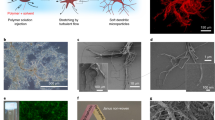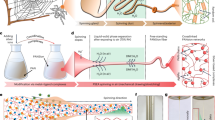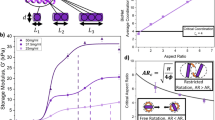Abstract
Fibrous media are functional and versatile materials, as demonstrated by their ubiquity both in natural systems such as feathers1,2,3,4 and adhesive pads5 and in engineered systems from nanotextured surfaces6 to textile products7, where they offer benefits in filtration, insulation, wetting and colouring. The elasticity and high aspect ratios of the fibres allow deformation under capillary forces, which cause mechanical damage8, matting5,9 self-assembly10,11 or colour changes12, with many industrial and ecological consequences. Attempts to understand these systems have mostly focused on the wetting of rigid fibres13,14,15,16,17 or on elastocapillary effects in planar geometries18 and on a fibre brush withdrawn from an infinite bath19. Here we consider the frequently encountered case of a liquid drop deposited on a flexible fibre array and show that flexibility, fibre geometry and drop volume are the crucial parameters that are necessary to understand the various observations referred to above. We identify the conditions required for a drop to remain compact with minimal spreading or to cause a pair of elastic fibres to coalesce. We find that there is a critical volume of liquid, and, hence, a critical drop size, above which this coalescence does not occur. We also identify a drop size that maximizes liquid capture. For both wetting and deformation of the substrates, we present rules that are deduced from the geometric and material properties of the fibres and the volume of the drop. These ideas are applicable to a wide range of fibrous materials, as we illustrate with examples for feathers, beetle tarsi, sprays and microfabricated systems.
This is a preview of subscription content, access via your institution
Access options
Subscribe to this journal
Receive 51 print issues and online access
$199.00 per year
only $3.90 per issue
Buy this article
- Purchase on Springer Link
- Instant access to full article PDF
Prices may be subject to local taxes which are calculated during checkout




Similar content being viewed by others
References
Rijke, A. M. & Jesser, W. A. The feather structure of dippers: water repellency and resistance to water penetration. Wilson J. Ornithol. 122, 563–568 (2010)
Rijke, B. Y. A. M. The water repellency and feather structure of cormorants, Phalacrocoracidae. J. Exp. Biol. 48, 185–189 (1968)
Dawson, C., Vincent, J., Jeronimidis, G., Rice, G. & Forshaw, P. Heat transfer through penguin feathers. J. Theor. Biol. 199, 291–295 (1999)
Zi, J. et al. Coloration strategies in peacock feathers. Proc. Natl Acad. Sci. USA 100, 12576–12578 (2003)
Eisner, T. & Aneshansley, D. J. Defense by foot adhesion in a beetle (Hemisphaerota cyanea). Proc. Natl Acad. Sci. USA 97, 6568–6573 (2000)
Liu, K. & Jiang, L. Bio-inspired design of multiscale structures for function integration. Nano Today 6, 155–175 (2011)
Eadie, L. & Ghosh, T. K. Biomimicry in textiles: past, present and potential. An overview. J. R. Soc. Interface 6, 761–775 (2011)
Kamo, J., Hiram, T. & Kamada, K. Solvent-induced morphological change of microporous hollow fiber membranes. J. Membr. Sci. 70, 217–224 (1992)
O’Hara, P. D. & Morandin, L. A. Effects of sheens associated with offshore oil and gas development on the feather microstructure of pelagic seabirds. Mar. Pollut. Bull. 60, 672–678 (2010)
Pokroy, B., Kang, S. H., Mahadevan, L. & Aizenberg, J. Self-organization of a mesoscale bristle into ordered, hierarchical helical assemblies. Science 323, 237–240 (2009)
Chandra, D. & Yang, S. Stability of high-aspect-ratio micropillar arrays against adhesive and capillary forces. Acc. Chem. Res. 43, 1080–1091 (2010)
Chandra, D., Yang, S., Soshinsky, A., a & Gambogi, R. J. Biomimetic ultrathin whitening by capillary-force-induced random clustering of hydrogel micropillar arrays. ACS Appl. Mater. Interfaces 1, 1698–1704 (2009)
Princen, H. Capillary phenomena in assemblies of parallel cylinders III. Liquid columns between horizontal parallel cylinders. J. Colloid Interface Sci. 34, 171–184 (1970)
Wu, X.-F., Bedarkar, A. & Vaynberg, K. A. Droplets wetting on filament rails: surface energy and morphology transition. J. Colloid Interface Sci. 341, 326–332 (2010)
Bedarkar, A., Wu, X.-f. & Vaynberg, A. Wetting of liquid droplets on two parallel filaments. Appl. Surf. Sci. 256, 7260–7264 (2010)
Minor, F. W., Schwartz, M., Wulkow, E., a & Buckles, L. C. Part III: The behavior of liquids on single textile fibers. Text. Res. J. 29, 940–949 (1959)
Keis, K., Kornev, K. G., Kamath, Y. K. & Neimark, A. V. in Nanoengineered Nanofibrous Materials (eds Guceri, S., Gogotsi, Y. G & Kuznetsov, V. ) 173–180 (Kluwer, 2004)
Kwon, H.-M., Kim, H.-Y., Puëll, J. R. M. & Mahadevan, L. Equilibrium of an elastically confined liquid drop. J. Appl. Phys. 103, 093519 (2008)
Roman, B. & Bico, J. Elasto-capillarity: deforming an elastic structure with a liquid droplet. J. Phys. Condens. Matter 22, 493101 (2010)
Hubbe, M. A. Bonding between cellulosic fibers in the absence and presence of dry-strength agents - a review. BioResources 1, 281–318 (2006)
Prakash, M., Quéré, D. & Bush, J. W. M. Surface tension transport of prey by feeding shorebirds: the capillary ratchet. Science 320, 931–934 (2008)
Py, C., Bastien, R., Bico, J., Roman, B. & Boudaoud, A. 3D aggregation of wet fibers. Europhys. Lett. 77, 44005 (2007)
Hartung, R. Energy metabolism in oil-covered ducks. J. Wildl. Mgmt 31, 798–804 (1967)
Acknowledgements
C.D. and H.A.S. acknowledge Unilever and the NFS for financial support. S.P. acknowledges financial support from the Emergence(s) Program of the City of Paris and CNRS and thanks Princeton University for its hospitality. We thank A. Lips and P. Warren for comments.
Author information
Authors and Affiliations
Contributions
C.D. and S.P. designed the experiments; A.Y.B., C.D. and S.P. carried out the experiments; C.D., S.P. and H.A.S. discussed and interpreted the results; C.D. and H.A.S. developed the models; and C.D., S.P. and H.A.S. wrote the manuscript.
Corresponding author
Ethics declarations
Competing interests
The authors declare no competing financial interests.
Supplementary information
Supplementary Information
This file contains Supplementary Text and Data, Supplementary Figures 1-7 with legends, Supplementary Table 1 and legends for Supplementary Movies 1-3. (PDF 4892 kb)
Supplementary Movie 1
This movie shows the evolution of a drop of volume V = 2 μL on a rail formed by two fibres of length L =3 cm and separated by a distance d0 = 0.76 mm, viewed simultaneously from the side and the top. (MOV 10616 kb)
Supplementary Movie 2
This movie shows the evolution of a drop of volume V = 2 μL on a rail formed by two fibres of length L =4 cm and separated by a distance d0 = 0.76 mm, viewed simultaneously from the side and the top. (MOV 11876 kb)
Supplementary Movie 3
This movie shows the evolution of a drop of volume V = 2 μL on a rail formed by two fibres of length L =3.5 cm and separated by a distance d0 = 0.76 mm, viewed simultaneously from the side and the top. (MOV 9718 kb)
Rights and permissions
About this article
Cite this article
Duprat, C., Protière, S., Beebe, A. et al. Wetting of flexible fibre arrays. Nature 482, 510–513 (2012). https://doi.org/10.1038/nature10779
Received:
Accepted:
Published:
Issue Date:
DOI: https://doi.org/10.1038/nature10779
This article is cited by
-
Surface-engineered microfibers provide liquid transport flexibility
Nature Chemical Engineering (2024)
-
Bioinspired directional liquid transport induced by the corner effect
Nano Research (2023)
-
Physical & mechanical and chemical properties on papaya tree bast fibers from different portions
Biomass Conversion and Biorefinery (2023)
-
Non-specific adhesive forces between filaments and membraneless organelles
Nature Physics (2022)
-
Topological heterogeneity and evaporation dynamics of irregular water droplets
Scientific Reports (2021)
Comments
By submitting a comment you agree to abide by our Terms and Community Guidelines. If you find something abusive or that does not comply with our terms or guidelines please flag it as inappropriate.



